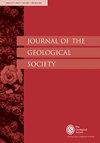Biological extinction and photic-zone anoxia across the Triassic-Jurassic transition: Insights from the Qiangtang Basin, eastern Tethys
IF 3
3区 地球科学
Q2 GEOSCIENCES, MULTIDISCIPLINARY
引用次数: 0
Abstract
The end-Triassic mass extinction (ETME) is one of the five catastrophic extinction events. However, the driving mechanisms of biodiversity loss during this interval remain controversial. In this study, we investigate the marine sediment geochemistry and fauna across the Triassic-Jurassic boundary in the Wenquan section of Qiangtang Basin, and the triggering mechanism of the Late Triassic extinction in the eastern Tethys Ocean. Our study shows that the main pulse of the ETME occurred in Bed 8, manifesting as the disappearance of four brachiopod species, a significant decrease of other faunas, and the “Lilliput Effect” on bivalves. Analyses of pyrite framboids and redox-sensitive trace elements, suggest the development of photic zone anoxia near the T/J boundary and coincident with the Late Triassic extinction. Thus, the development of abrupt and intense photic-zone anoxia could play an important role in the end-Triassic extinction. Supplementary material: https://doi.org/10.6084/m9.figshare.c.6771606特提斯东部羌塘盆地三叠系—侏罗系生物灭绝和光带缺氧
三叠纪末大灭绝(ETME)是五大灾难性灭绝事件之一。然而,在此期间生物多样性丧失的驱动机制仍然存在争议。本文研究了羌塘盆地温泉段三叠纪-侏罗纪界线的海洋沉积物地球化学和动物群,以及特提斯洋东部晚三叠纪灭绝的触发机制。我们的研究表明,ETME的主脉冲发生在第8床,表现为四种腕足动物的消失,其他动物群的显著减少,以及对双壳类的“小人国效应”。黄铁矿碎片和氧化还原敏感微量元素的分析表明,在T/J边界附近形成了透光带缺氧,与晚三叠纪灭绝相吻合。因此,突然而强烈的光带缺氧的发展可能在三叠纪末的灭绝中发挥重要作用。补充材料:https://doi.org/10.6084/m9.figshare.c.6771606
本文章由计算机程序翻译,如有差异,请以英文原文为准。
求助全文
约1分钟内获得全文
求助全文
来源期刊

Journal of the Geological Society
地学-地球科学综合
CiteScore
6.00
自引率
3.70%
发文量
68
审稿时长
6-12 weeks
期刊介绍:
Journal of the Geological Society (JGS) is owned and published by the Geological Society of London.
JGS publishes topical, high-quality recent research across the full range of Earth Sciences. Papers are interdisciplinary in nature and emphasize the development of an understanding of fundamental geological processes. Broad interest articles that refer to regional studies, but which extend beyond their geographical context are also welcomed.
Each year JGS presents the ‘JGS Early Career Award'' for papers published in the journal, which rewards the writing of well-written, exciting papers from early career geologists.
The journal publishes research and invited review articles, discussion papers and thematic sets.
 求助内容:
求助内容: 应助结果提醒方式:
应助结果提醒方式:


